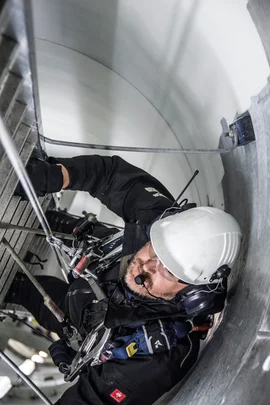Figures do not lie. There are still too many accidents when working in confined spaces. By 2015, as many as 11 fatalities have been reported when entering confined spaces. When working in confined spaces, the use of fall protection is very important. In this type of high-risk work, even fall protection with a rescue function is indispensable.
Working in confined spaces and knowing what to do in the event of an emergency can be trained. In situations where access to or rescue work has to be carried out in confined spaces, safety equipment must work quickly and without faltering. Enclosed spaces vary in size, shape and location. There is no standard solution or common application.
However, there is good advice, high quality products and training to ensure that staff are well prepared, confident and safe to work in confined spaces. Accidents are not always preventable, but people are better equipped to act and act in a rescue manner. Working in confined spaces usually requires specific fall protection equipment, so that an employer has a duty to provide thorough training for its employees so that they can carry out the work and work with this equipment.
In accordance with the Working Conditions Act (Article 8), PPE user directive 89/656 and instructions for use, the employer is always obliged to take care of this when using personal fall protection equipment. It is important that your employer complies with the applicable laws and regulations and ensures that employees return home safely at the end of the day!
The know-how to navigate in confined spaces.
Contact us for more information

What is a confined space?
The definitions of a confined space vary from country to country (see relevant national regulations), but the common criteria often relate to it:
- An area that is largely or completely enclosed
- Containing health and/or safety hazards
- Which is not designed for continuous residence by a worker
- Who has limited possibilities to enter and leave them
- A space large enough to allow full access and to carry out the assigned work there
- Which has limited air circulation
What are the unique challenges in confined spaces?
No two enclosed spaces are exactly the same. The type, size and hazards are very different, as are the different standards, rules and company policies that can apply to different work environments.

Common forms of confined spaces
Safe entry and exit starts with identifying the work areas:
- Storage tanks
- Divers
- Tunnels
- Lift shafts
- Air ducts
- Trench shoring
- Utility rooms
Where confined spaces are found
Working safely in confined spaces is universal, but various industries have their own challenges:
- Pharmaceutical production
- Chemical production
- Food and beverage production
- Oil and gas
- Waste water treatment

Hazards in confined spaces
Many different types of hazards are found in confined spaces, whether they are inherent to the space or caused by the task being performed. Common potential hazards are:
- Fire and/or explosion
- Extreme temperatures
- Loss of consciousness or suffocation caused by the environment (including lack of oxygen, suffocation-causing dust and toxic environments)
- Drowning
- Burial
How to work safely in confined spaces
Four elements for successful confined space management:
- Planning - before you start working in a confined space, you will need to develop a step-by-step method for carrying out the task, taking into account the hazards and risks and clearly indicating all the control measures needed to work safely.
- Entry and exit - where you have access to the confined space.
- Inside work - communication and respiratory protection.
- Rescue and retrieve - make sure your team has a plan ready and trained.
Want to know more? Discover all our white papers on confined spaces:
- Enclosed spaces, where to find them?
- Enclosed spaces: definitions, regulations and statistics
- Common forms of confined spaces
- Hazards in confined spaces
- The 4 pillars for successful preparation and management of confined spaces
Leave your details and discover all the whitepapers:


Closed Spaces training
Training is crucial to ensure that people entering confined spaces, attendees, supervisors and rescue workers are aware of the dangers that can arise in confined spaces and receive the appropriate training to carry out their work safely. We help employers meet training requirements by offering a full range of confined space training under the guidance of an experienced trainer.
More information
Work and rescue in convined spaces
Range of fall protection and rescue equipment
We offer a very wide range of fall protection and rescue equipment for entering and leaving confined spaces.





